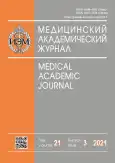Growth characteristics of experimental live influenza vaccine strains with modified NP and NS genes
- Authors: Prokopenko P.I.1, Matyushenko В.A.1, Isakova-Sivak I.N.1, Rudenko L.G.1
-
Affiliations:
- Institute of Experimental Medicine
- Issue: Vol 21, No 3 (2021)
- Pages: 135-139
- Section: Conference proceedings
- Published: 06.12.2021
- URL: https://journals.eco-vector.com/MAJ/article/view/77800
- DOI: https://doi.org/10.17816/MAJ77800
- ID: 77800
Cite item
Abstract
BACKGROUND: Vaccination is the most effective means of fighting influenza epidemics, but the immunogenicity of licensed influenza vaccines is not always satisfactory. One of the ways to increase the immunogenicity of an attenuated live influenza vaccine is to shorten the open reading frame of the NS1 protein, a modulator of innate antiviral immunity. In addition, the T-cell response to vaccination can be optimized by including the NP gene from the epidemic parental virus into the genome of vaccine strains.
MATERIALS AND METHODS: The open reading frame of the NS1 protein of the master donor virus A/Leningrad/134/17/57 was truncated to 126 amino acids by site-directed mutagenesis. The HA, NA, and NP genes of the model virus A/Anhui/1/2013 (H7N9) were cloned into the pCIPolISapIT vector. The rescue of recombinant influenza viruses was performed by transfection of Vero cells with a desired set of plasmids. The growth properties of the recombinant viruses were determined in embryonated chicken eggs incubated at different temperatures, as well as in the tissues of the respiratory tract of mice (nasal turbinates, lungs).
RESULTS: Experimental live influenza vaccine strains of subtype H7N9 with genome compositions 6:2 and 5:3 and carrying a full-length or truncated NS1 gene were actively replicated in eggs under optimal conditions, while maintaining the temperature-sensitive and cold-adapted phenotypes characteristic of classical live influenza vaccine strains. All viruses lacked the ability to grow in the lungs of C57BL/6J mice, which confirms the attenuated phenotype of the viruses. In the nasal passages of mice, only viruses with the full-length NS1 gene replicated, while viruses expressing the truncated NS1 protein were not detected in the respiratory tract of animals.
CONCLUSIONS: The results indicate that modification of the NS1 gene of the vaccine virus and the inclusion of wild-type NP gene in its genome does not affect its growth characteristics in eggs. A decrease in the activity of viral replication in the upper respiratory tract of mice with a shortening of the NS1 open reading frame indicates an increase in the attenuating properties of modified vaccines, which opens up prospects for the use of new vaccines in children under three years of age.
Full Text
About the authors
Polina I. Prokopenko
Institute of Experimental Medicine
Author for correspondence.
Email: pi.prokopenko@gmail.com
Postgraduate student, Research Assistant
Russian Federation, Saint PetersburgВиктория A. Matyushenko
Institute of Experimental Medicine
Email: small.scorpion@gmail.com
ORCID iD: 0000-0002-4698-6085
SPIN-code: 1857-1769
Researcher
Russian Federation, Saint PetersburgIrina N. Isakova-Sivak
Institute of Experimental Medicine
Email: isakova.sivak@iemspb.ru
ORCID iD: 0000-0002-2801-1508
SPIN-code: 3469-3600
Dr. Sci. (Biol.), Head of Laboratory
Russian Federation, Saint PetersburgLarisa G. Rudenko
Institute of Experimental Medicine
Email: vaccine@mail.ru
ORCID iD: 0000-0002-0107-9959
SPIN-code: 4181-1372
Dr. Sci. (Med.), Professor, Honored Scientist of the Russian Federation
Russian Federation, Saint PetersburgReferences
- Iuliano AD, Roguski KM, Chang HH, et al. Estimates of global seasonal influenza-associated respiratory mortality: a modelling study. Lancet. 2018;391(10127):1285–1300. doi: 10.1016/S0140-6736(17)33293-2
- Marc D. Influenza virus non-structural protein NS1: interferon antagonism and beyond. J Gen Virol. 2014;95(Pt 12):2594–2611. doi: 10.1099/vir.0.069542-0
- Pica N, Langlois RA, Krammer F, et al. NS1-truncated live attenuated virus vaccine provides robust protection to aged mice from viral challenge. J Virol. 2012;86(19):10293–10301. doi: 10.1128/JVI.01131-12
- Zhou B, Li Y, Belser JA, et al. NS-based live attenuated H1N1 pandemic vaccines protect mice and ferrets. Vaccine. 2010;28(50):8015–8025. doi: 10.1016/j.vaccine.2010.08.106
- Isakova-Sivak I, Korenkov D, Smolonogina T, et al. Comparative studies of infectivity, immunogenicity and cross-protective efficacy of live attenuated influenza vaccines containing nucleoprotein from cold-adapted or wild-type influenza virus in a mouse model. Virology. 2017;500:209–217. doi: 10.1016/j.virol.2016.10.027
- Rekstin A, Isakova-Sivak I, Petukhova G, et al. Immunogenicity and cross protection in mice afforded by pandemic H1N1 live attenuated influenza vaccine containing wild-type nucleoprotein. Biomed Res Int. 2017;2017:9359276. doi: 10.1155/2017/9359276
- Reed LJ, Muench H. A simple method of estimating fifty per cent endpoints. American Journal of Epidemiology. 1938;27(3):493–497. doi: 10.1093/oxfordjournals.aje.a118408
- Vasin AV, Temkina OA, EgorovVV, et al. Molecular mechanisms enhancing the proteome of influenza A viruses: an overview of recently discovered proteins. Virus Res. 2014;185:53–63. doi: 10.1016/j.virusres.2014.03.015
Supplementary files








